Question about Finger Training Methodology
November the 22nd, 2011By Joaquín
Hi Eva,
I will tell you some details of my experience... Some time ago I started with sport climbing, but I didn't feel committed enough and so I ended up retreating into the gym, without the need of a specific training. A year ago I discovered that I was more comfortable bouldering, and I wanted to make progress... The online-guinea-pig thing looks interesting, so I'll tell you about my training and you'll see what you make of it.
Mi height is 167 cm and my weight 67 kg with 13% body fat. I own an old top30 fingerboard, on which I do the following training:
Sets an rest period: I do 3 sets to exhaustion without added weight: 2 on a 20 mm edge and 1 on a 15 mm edge; the rest between sets is 3'.
Effort duration: on the 20 mm edge I usually reach failure at 30-35'', and 25-30'' for the 15mm one depending on the day.
I also distribute the other weekly contents like this:
Monday: training with weights
Tuesday: at the climbing gym, 4 boulder problems that I am able to do and 2 or 3 that I'm not
Wednesday: the finger training session I described previously
Thursday: gym, similar to Tuesday
Friday: training with weights
Weekend: go out bouldering if I can...
Well, I know that's a handful, thank in advance.
ANSWER:
Well, Joaquín, thank you for your confidence in my opinion.
Let's take one aspect of your plan at a time:
Firstly it's been proven that training to "muscular failure" has a similar effect on increasing maximum strength than stopping 1 or more repetitions before total exhaustion (this margin I will expand on later is called Effort Level (EL).
Failure is something we seek when training strength-endurance, but only if we have enough experience with it.
Secondly, using those exertion lengths (15'' or more) has an effect on finger endurance, but not on maximum strength. Furthermore, and according to my research, you will improve your endurance for those edge depths but not for the smaller ones.
So, given your mark of 35'' on 20 mm, I suggest you perform twice a week for 8 weeks (resting at least 48 hours between sessions) the following periodization or combination of methods:
a) 4 weeks of 3-4-5-5 sets (i.e. 1st week 3 sets,2st week 4 sets... last week 5 sets) of 10-second repetitions with 3' rest between them; the edge depth would be 20 mm and the Effort Level (EL) 3, meaning that you would choose the amount of added weight that would permit you to hang for 13 (10+3) seconds but you hang only for 10 seconds; this is written 10''(3).
b) 4 weeks of 3-4-5-5 sets of dead hangs on the smallest edge that you can hold for 10''(3) (effort level of 3) and resting 3' between sets. By the way, for the second week this would be expressed like this: 4 x 10''(3) :3'. The figure after the colon denotes the resting time.
The key aspect with the training is controlling and adjusting the training load. This is completely individual and you may have to adjust the training load every day or even set if you wish to progress. I recommend to keep the same EL throughout a period, and to increase/decrease the amount of weight/edge size every day and even every set as your strength and performance changes.
With this methodology, based on the conclusions of my research, you will be able to:
-Increase your maximum time on the 20 mm edge
-Hold from smaller edges than before
-Hold longer to medium (20-15 mm) and small (11 mm or less) edges
-Decrease the delay between grabbing a hold and applying the maximum force on it (to shorten time to peak force), therefore saving on power and duration of the grip, delaying fatigue
The description of this periodization and the study it's based on are in the following (soon to be translated into English) blog entry:
If later on you want to improve your power-endurance over small edges, you could use the intermittent dead hangs method, that can be found in the training guidelines that are included with each Progression or Transgression fingerboard; or in the following video:
Question about Managing the Effort Duration when preparing a Finger Training Periodization
December the 2nd, 2011
By Tato
Hi Eva, how's everything going?
I have the following question:
Why 10 seconds? Wouldn't it be advisable to modify the "time" parameter so you can vary the "edge size" parameter accordingly?
To make myself clear: currently, when performing dead hangs, I only use small edges. I feels it helps me to avoid injuries and the smaller edges are one of my weak points. Changing the edge even in 1 mm steps doesn't look like much, but they are big leaps for me and the process requires time, adaptation and effort.
I can't do 10'' repetitions on 8 mm but I'm able to do 5'' repetitions. I have noticed that, while I was getting better on a given edge, I barely improved on the smaller ones. But in few sessions I have experienced gains in strength by varying the time and size parameters and the number of sets.
I wait for your opinion, and wish you good luck in everything.
ANSWER:
Hi Tato,
It's true that the time parameter can be adjusted, it is the equivalent of doing more or less repetitions in other exercises like weight lifting or pull-ups.
Remember that the first periodization that I proposed time ago, consisted of just 8 weeks doing 10-second repetitions, and that is fine to begin. But clearly we don't want to keep repeating that kind of load time and again because we wouldn't progress.
Of course, the parameters have to be changed. And after playing with the EL (explained above) we can vary the duration of the effort. Congratulations, you have worked out by yourself the appropriate planning strategy ;)
The type of periodization that you have chosen, with shorter effort duration on smaller edges (or with more added weight) is precisely the one that I propose in the training guidelines for the Transgression fingerboard. I will give more details about it in a future entry.
Anyway, if you look at the poster that comes with Progression, in the suggested training plan I first advise to lower the EL from (5) to (3), and gradually go from 15 to 12 and finally 10'' because this is the most advisable path for the potential users of Progression or those who start training in a systematic way.
 |
| Progression in our gym. And besides it the poster with the training guidelines |
The same goes for intermittent dead hangs for developing strength-endurance, where I even give the possibility of using added weight (3-5x4-6x10"-5":3"-5"/1').
Now regarding the use of methods without added weight: they are indicated for lower and medium level climbers, and I guess for you too, because you still don't reach the 8-second mark on a 10 mm edge. With them you can certainly improve a lot, and they are what's used during the first phases of training on Progression.
 |
| My pupil Nacho Sánchez in Entropía, 8C. Castillo de Bayuela (Toledo). Photo by Raúl Santano |
 |
| My pupil Luis Alfonso Félix sending Black Block, 9a+ . Cuenca. Photo by Javipec |
-10 seconds for 4 to 8 weeks
-8 seconds in a 4-week cycle
-a last cycle of 5 seconds for 2 to 4 weeks
Once you have achieved a certain level, though, training first with added weight and then without it is more effective regarding my research. Both for developing maximum strength and strength-endurance on small edges.
More articles here






























 https://orcid.org/0000-0003-0304-5290
https://orcid.org/0000-0003-0304-5290







